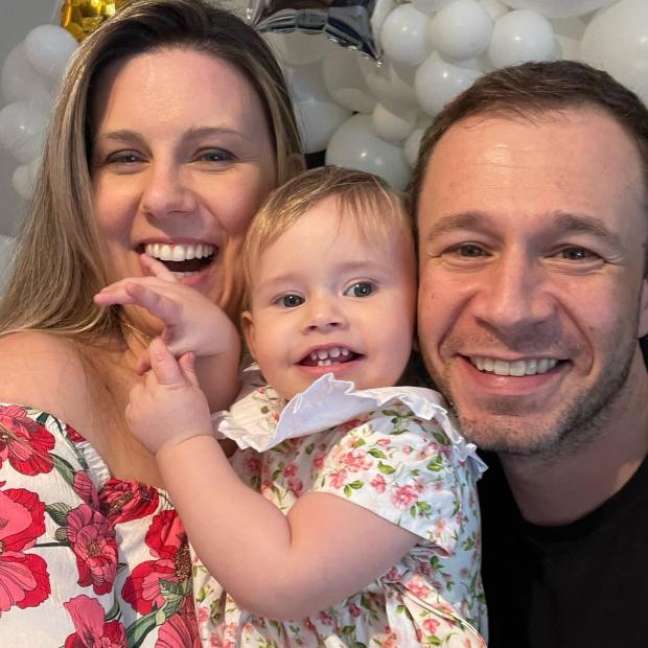The case of the daughter of Tiago Leifert and Daiana Garbin reinforces the importance of starting to take care of children’s eyes from an early age: knowing when to take your child to the ophthalmologist and what signs to look out for to detect problems
1-year-old Lua was diagnosed with a rare type of eye cancer called retinoblastoma🇧🇷 The parents, the presenter Tiago Leifert and the journalist Daiana Garbin thought about it a thousand times before making the issue public, but, even a little fearful, they decided to do it, precisely to warn about the importance of early diagnosis . For this, it is essential that parents take their children to the ophthalmologist from an early age. We spoke to an expert to figure out when and how these routine appointments should be made and what parents need to worry about.

In addition to talking about the importance of eye exams and routine visits, pediatric ophthalmologist Márcia Ferrari, from H.Olhos – Hospital de Olhos, in São Paulo (SP), lists the signs adults should be aware, as they may indicate that something is wrong with the child’s health. Watch!
Little eye test: the first evaluation of the child’s eyes
🇧🇷Since 2017, the law has been passed requiring the red reflex test (small eye test) to be performed in newborns, in all public and private hospitals and maternity wards in the country, for the screening of eye diseases” , explains Márcia.The eye exam should preferably be performed within the first 48 hours of the child’s life or before he is discharged and released to go home from the maternity ward.
“During the red reflex exam, the congenital pathologies already present at birth are examined. These pathologies can manifest themselves in the first months and years of the child’s life and it is precisely for this reason that it is important to carry out the exam in advance”, adds the specialist . The sooner problems are detected, the better the chances of minimizing damage to vision.
How often to take the child to the eye doctor?
Many parents leave routine appointments to start later, often when the child is already school-age and has some complaints, such as difficulty seeing the blackboard or constant headaches. In fact, the cure should start much earlier! “Considering this first evaluation, the eye examination, parents should schedule the second evaluation at 6 months of life and the third at 1 year of age, to then maintain the annual evaluations”, points out the doctor.
The most common problems detected in the eyes of the child in the first months of life
But what can affect children’s vision so early? There are several possibilities that caregivers, parents and caregivers should be aware of. “In the first months of life, signs of congenital cataract, congenital glaucoma, strabismus, lacrimal duct obstruction and retinoblastoma may appear. [o câncer que afeta Lua]🇧🇷 All of these diseases can impair the child’s vision development and must be diagnosed as early as possible in order to establish treatment and preserve the developing vision”, Márcia reinforces.
Signs that something may be wrong with your baby’s vision
Children with good eyesight interact well with their environment: they search and pick up objects with precision, respond to parental commands with their eyes, and walk confidently. So, if you realize something is different, seek a professional appraisal. “Impaired eye health is also demonstrated by the perception of abnormalities such as crooked eyes, eyelid asymmetry, eye discharge, red eyes and swelling in the eye area. Parents should always observe the photographic reflection of the eyes, which should be symmetrical and orange-red in color,” says the ophthalmologist.
But beware: Just because your baby looks perky, doesn’t have any of the signs mentioned above, and interacts well with his environment, doesn’t mean you can skip or put off routine visits with a pediatric ophthalmology specialist. “Some initial lesions can only be detected with a thorough ophthalmological examination, performed by the ophthalmopediatrician, during the routine examination,” Márcia reinforces.
Some alterations observed by parents are natural in the child’s eye development and among these we can mention the incoordination of eye movements, false strabismus and ocular discharge.
Signs that may seem “strange” but are normal in the eyes of children
If you’ve ever been desperate, breathe and keep calm. Routine appointments are important, but there are some changes that may seem worrisome, but are normal in children’s eyes. In the first few months of life, for example, infants’ eye movements are uncoordinated and some may show false squints and discharge.
“The incoordination of eye movements can occur physiologically up to 6 months of life, but it must always be evaluated because it can be a sign of low vision”, says the ophthalmologist. “Just be careful not to confuse these movements with nystagmus, which is eye tremor and can be indicative of low vision or have a neurological cause,” she cautions.
“False strabismus (also called pseudostrabismus) occurs when the position of the eyes appears to show a deviation, but in reality the eyes are aligned and vision development is normal. In these cases there is nothing to worry about and nothing, however, you need to confirm with your pediatric ophthalmologist that it’s not a true strabismus,” she explains.
The presence of secretion in small quantities, without redness and without swelling, can also be common in newborns and does not represent any type of problem. According to the doctor, this happens because the ocular surface is adapting to the environment. “A small increase in this secretion can be associated with an increase in nasal secretion or with a congenital obstruction of the tear tract. In any case, it is advisable to consult a pediatric ophthalmologist to make sure that these are physiological alterations and to know how to proceed in these cases,” he advises.
Questions you need to ask the doctor at your child’s first visit to the ophthalmologist
“In the first consultation with the ophthalmologist, parents should ask what is the ideal frequency of consultations with the ophthalmologist (this is what I call ophthalmological childcare), how to stimulate the child’s visual development and most importantly: ask yourself what should be observed in the child’s behavior”, clarifies Márcia.
What happens? Ready to book your child’s first appointment?
It’s still:
Want to know more? Subscribe to the newsletter Baby Home and get more tips each week on how your baby is developing. It’s fast and free.
🇧🇷The best content in your email for free. Choose your favorite Terra newsletter. Click here!
Source: Terra
Ben Stock is a lifestyle journalist and author at Gossipify. He writes about topics such as health, wellness, travel, food and home decor. He provides practical advice and inspiration to improve well-being, keeps readers up to date with latest lifestyle news and trends, known for his engaging writing style, in-depth analysis and unique perspectives.





-vf6huy5jc37c.jpg)

